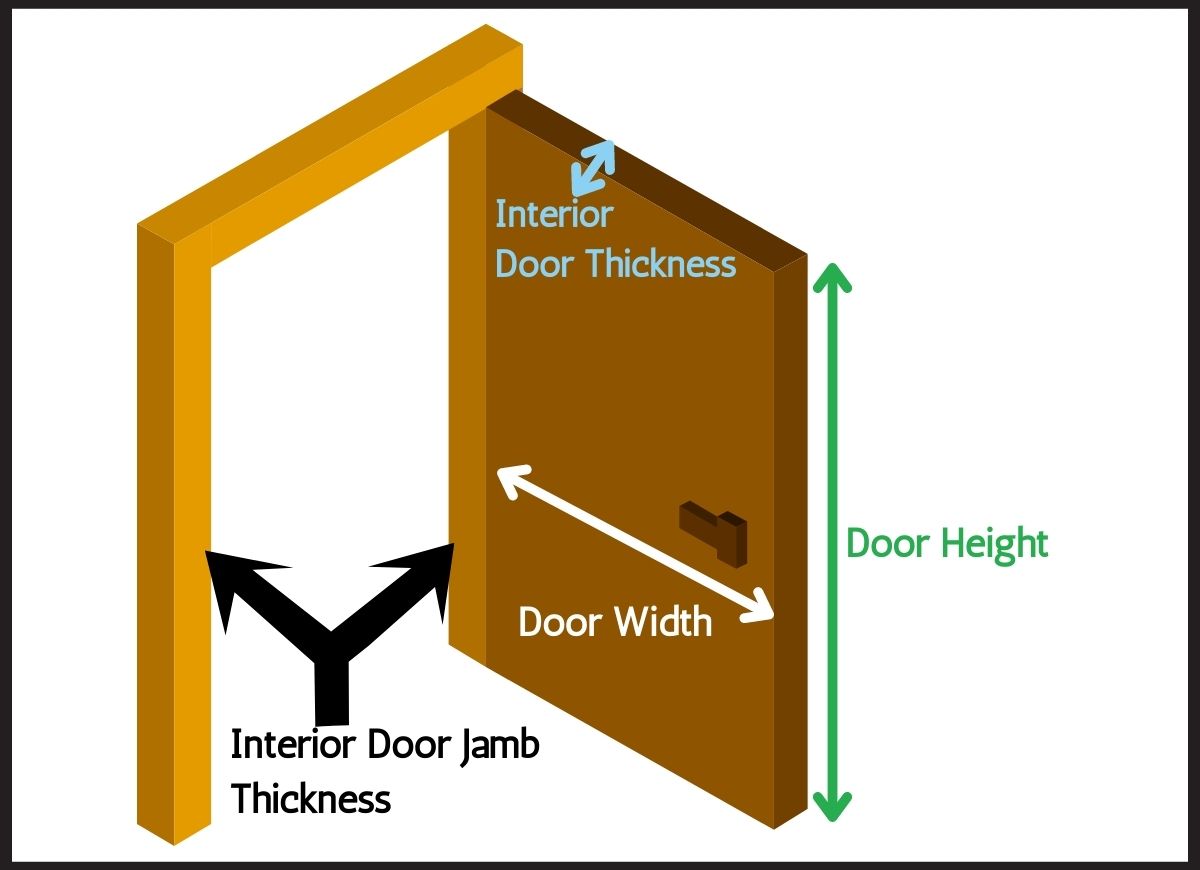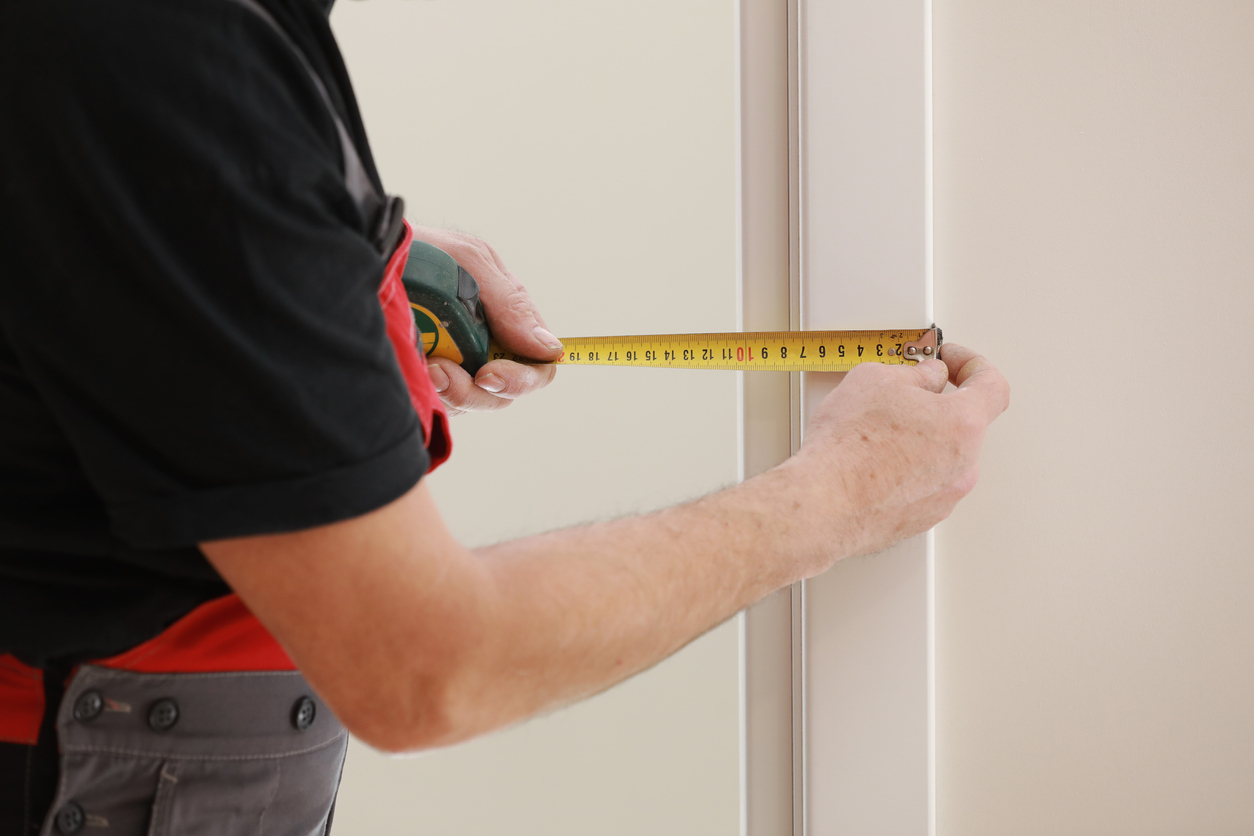

We may earn revenue from the products available on this page and participate in affiliate programs. Learn More ›
Door sizes in older homes are anything but standard, as houses that predate standardized manufacturing and local building codes often incorporate older doors that were often crafted by hand. Today, doors come in standard sizes that many home improvement centers and online retailers keep in stock, which makes it easy for DIY-ers to grab them straight off the rack.
In addition to stocking standard door sizes, many retailers and lumber yards keep some of the less common sizes on hand, which DIYers can use in certain areas of the house. By and large, the simplest and least expensive way to install or replace a door is to get one in a standard size that can accommodate other standardized building products. What are the standard door sizes, and what do all the measurements mean?
RELATED: 23 Types of Doors All Homeowners Should Know
Standard Interior Door Dimensions

There are standard interior door sizes, and there are some alternatives available. Before selecting a new door, it can be helpful to understand the reasoning behind standard door widths and heights.
Door Measurement Lingo
Contractors, carpenters, supply houses, and others in the building trade have specific jargon that they use to describe door sizes. Rather than saying “30 inches wide, 80 inches tall” or “2 feet 6 inches wide, 6 feet 8 inches tall,” they’ll refer to the door as a “2/6, 6/8 door,” pronounced “two-six, six-eight.” For a door that is 24 inches wide and 78 inches tall, they’ll refer to it as a “2/0, 6/6” door. Pros and building suppliers will always state a door’s width before stating the height.
Width
Homeowners may think they have the right to design and style the interiors of their homes any way they’d like, but that’s not the case. All builders, DIYers, and industry folks have to follow building codes, and these codes include instructions regarding standard interior door sizes. The following are some of the most common standard interior door widths:
- The standard door width for interior doors is 32 inches. Described as a “2/8” door, this 2-foot 8-inch-wide door is the minimum recommended width required for a passage door. Some authorities may allow for smaller existing doors to be replaced with the same size door, but renovations, additions, or new construction often require 2/8 passage doors.
- Some retailers stock narrower doors, but they’re typically reserved for closets and utility spaces. It’s possible to find ready-made doors with widths of 30 inches, 28 inches, and 24 inches, but they’re almost always reserved for closets and utility-access areas. In some cases, a homeowner may be allowed to replace a 2/6 (30-inch-wide) passage door in an older home with another 2/6 door—that is, if the local building inspector approves.
- You may find 36-inch-wide doors in stock. These wider portals are compliant with the Americans with Disabilities Act (ADA). They’re popular choices for homes whose residents have mobility issues, or for homeowners who are planning to age in place.
Height
The standard door height of interior passage doors—or, doors that people walk through—is 80 inches. Closet doors may be slightly shorter, at 78 inches.
The door installer must meet these minimum height requirements, but they can absolutely exceed them if the home’s dimensions allow for it. If a homeowner wants a bedroom door that’s 96 inches tall, they may do so as long as there is enough room under the header (the structural member above the doorway).
- Standard door height for interiors is 80 inches. An 80-inch-tall door is the most common height for passage doors that lead from one room to another. This 6-foot, 8-inch-tall door is called a 6/8 door.
- Closet doors can be slightly shorter, at 78 inches. Called a 6/6 door, the 6-foot 6-inch-tall door is used for closets, mechanical or utility rooms, or other doors that people don’t usually walk through.
Interior Thickness
Interior door thicknesses aren’t nearly as confusing or jargon-heavy as heights or widths. When shopping for interior doors, you generally have a choice of one of two thicknesses: 1⅜ and 1½ inches. These are both common sizes within residential structures, and they can be either hollow core (nothing inside the door but air and a few framing members) or solid core (typically filled with foam or sawdust). There are doors that are a quarter-inch thicker, but they’re fire doors designed to resist the spread of fire.
- The standard interior door thickness is 1⅜ inches. This is the most common interior door thickness. If your home improvement store only stocks one door thickness, this is it.
- Some stores may stock doors that are 1½ inches and 1¾ inches thick. These are slightly thicker than standard and are often insulated or made from hardwood. The thicker of the two, 1¾ inches, is typically used as a fire door.
Other Important Measurements

We’re not done with door math quite yet! When selecting a replacement door for your home, a contractor or home store retailer may ask you for a few other stats to ensure you get the right fit. Here’s what else you may need to know about your interior doors.
Interior Door Jamb Thickness
Door jamb thickness refers to the depth of the frame that surrounds the door. Door jamb thickness is typically determined by framing lumber in the wall. For standard interior walls constructed of 2x4s, standard jamb thickness is 4 9/16 inches. For load-bearing walls and exterior passageways that are constructed of 2x6s, standard jamb thickness is 6 9/16 inches.
- Standard interior door jamb thickness on prehung doors is 4 9/16 inches. The door jamb is the frame that installs in the wall and supports the door via its hinges. This thickness is designed for installation in a standard 2×4 wall constructed by 1½-inch by 3½-inch studs with standard drywall on either side of the stud wall.
- An alternate jamb thickness is 6 9/16 inches. This jamb is designed to fit 2×6 wood stud walls constructed by studs that are 1 ½ inches by 5½ inches with drywall and exterior sheathing.
Ceiling Height
Ceiling height and door height don’t need to correlate but there are instances when it’s worth considering. For instance, a standard 6/8 door in a room with a 10-foot ceiling may look diminutive in scale. In this case, a larger 8/0 door can look more appropriate. There aren’t any hard and fast rules on the topic, unfortunately, so just think about tall doors for tall ceilings.
Also, doorways in load-bearing walls have headers above them. These headers serve to distribute the weight of the structure to either side of the door frame. This header cannot be removed without causing unsafe structural issues that go against building codes in most cases, so it may not be possible to go with a taller door.
When It Makes Sense Not to Have a Standard-Size Door

While there are standard door sizes and building codes that require them, there are a few exceptions to the rules. Entry doors in large foyers are often very tall, and those in older homes don’t need to fit the same requirements or codes in some cases. The following are some of the most common exceptions to the standard door sizing rules.
Entry Doors

While a door width of 36 inches is oversized for an interior door, it’s the standard size for entry doors. The standard height remains the same, however, at 80 inches. These slightly wider doors make it possible to move appliances and large furniture items into the home.
Most standard exterior door sizes are slightly thicker than interior doors as well, with a standard thickness of 1¾ inches. Standard jamb thicknesses are similar to interior door jamb thicknesses, either 4-9/16 inches or 6-9/16 inches to fit 2×4 and 2×6 walls, respectively.
Doors in Older Homes
Large doors can overwhelm small rooms, so if space is at a premium, a narrower door can provide a cleaner look and add wall space. Before installing a narrower door, it’s important to check with the local building codes. Some municipalities require that all interior doors be at least 24 inches wide, and spaces larger than 10 square feet may need at least one door that is 32 inches wide.
Replacing a door with a slimmer update involves removing the old door and jamb and reconfiguring the rough-in frame in the wall so that a new prehung door will fit the space. This project is well within the capabilities of a DIYer with basic carpentry knowledge.
Doors That Are Wider Than They Need to Be
Grandma’s old Victorian-style couch might be well cared for and freshly reupholstered, but it may not fit the typical mold. If it’s too long for the room and overhangs the doorway, there might be a problem with using normal doors.
In most non-standard cases, the only option is to move the couch to another wall. However, if the door is 36 inches wide and doesn’t need to be by code or ADA regulations, it may be possible to remove the existing door and frame in order to downsize to a 2/8 door. This would potentially allow for 4 extra inches, helping Grandma’s couch or Aunt Betty’s custom armoire fit a little better behind the door.
Having a larger interior door opening may also be a benefit. For example, wider furniture can move more easily through a larger passageway.
When It Makes Sense to Order Custom Doors

Standard doors are just right in standard homes, but what kinds of doors are appropriate for custom stick-built, timber-frame, or post-and-beam homes? Walls in these types of homes can be of any height. In these situations, there may be no such thing as standard door sizes.
You Can’t Get Furniture Into (or Out of) the House
One situation in which it makes sense to spring for a custom door is when you’re remodeling an older home that has very narrow doorways. If you live in an older home you’ve surely discovered by now that it is difficult, if not impossible, to move larger pieces of furniture through these doorways (nevermind that they may not meet ADA accessibility guidelines). You may find a few 36-inch-wide doors stocked at the home center, but your best bet is usually to custom order doors to widths that make sense for your space. These doors should be installed by a skilled professional because the rough-in opening in the wall will have to be enlarged.
Your Prehung Door’s Measurements Aren’t Standard
A custom door might also make sense for you if you measure for a new prehung door and the measurements don’t closely align with standard door specifications. If you’re not prepared to enlarge or narrow the existing door frame to accommodate a standard-size door, know that manufacturers can make prehung doors to your exact specifications.
If you choose to go this route, your door will fit perfectly in its jamb, and open and close with ease. All that needs to be done is to remove the old door casing and trim, install the new door, and then reinstall the original casing and trim. Finally, paint or stain the new door to match.
RELATED: How to Install a Prehung Door
How to Measure for a New Door

Before measuring a door, it’s important to know whether you want a slab door or a prehung door. A slab door is just the door. It has no mortises for hinges, and there may not even be a hole for the door knob. A prehung door includes the door and the frame around it, including the hinges and a pre-drilled hole for the knob. Since there are no standard door hinge sizes (they vary in size and placement), rarely can a door come directly out of one prehung frame and fit another.
If you’re handy with a chisel, a slab door may be the best option. They’re less expensive and don’t require removing the old jamb or trim from the rough opening. You’ll measure just the door in this case. Prehung doors are the easiest option when the rough opening in the framing is open such as in new construction or when the old jamb is already removed.
How to Measure for a Prehung Door
Measuring a prehung door isn’t complicated, but there are a few steps that to follow to ensure that you purchase a door size that fits your rough opening. Once you have these measurements, you’ll probably be able to purchase a prehung model off the rack at the local home improvement center.
Believe it or not, the most important thing to measure when determining the size of a new prehung door isn’t the door or frame. It’s actually the rough opening.
- Carefully remove the door casing around the sides and top of the door frame. This should expose the rough opening or framing behind the drywall.
- Using a tape measure, pull a measurement from one side of the rough opening to the other. Because these rough openings are, well, rough, you’ll want to measure at the top, bottom, and middle of the frame. Use the largest of these measurements as your door width.
- Now, measure from the bottom edge of the top of the rough opening (the header) to the floor. Again, you’ll want to take multiple measurements—one from the left side of the top of the door, and one from the right side. Record the largest measurement.
For a standard 2/8, 6/8 door, the rough opening is typically around 34 inches wide and 82½ inches tall. This leaves enough room around the door’s frame for shimming, allowing the DIYer to achieve a perfectly plumb door.
Note: It’s important to take several measurements across the rough opening and go with the larger measurement. Door openings aren’t always square or consistent, and going with the larger measurement allows the installer to cut the door down if necessary.
How to Measure for a Slab Door
A slab door is just a door. It won’t have mortises for hinges, and sometimes it won’t even have a hole for the doorknob lockset. DIYers who purchase slab doors will have a bit of customizing to do, but a slab can be a slightly more affordable option than a prehung door. And, measuring for a slab door is as easy as it comes.
- Open the door all the way.
- Use a tape measure to determine the width of the door. Measure across the door in several areas from top to bottom (this step is particularly important if you have an older home). Record the largest measurement.
- Measure the door from top to bottom, making sure to measure both height of both the right and left side of the door. Record the largest measurement.
- Use the tape measure to check the door’s thickness. This should be consistent along the length of the door.
Pro tip: Select a new slab door with slightly larger measurements than the old door.
If you’re only replacing the door, not the jamb, a smaller door may result in gaps between the door and the jamb. Instead, buy a solid slab door that’s slightly larger and then shave it down to the exact size of the existing door. The tool for this job is a hand plane or power planer. In most cases, these tools can slice off small bits at a time, allowing users to achieve a perfect fit.
As a DIY project, expect fitting a slab door to be time-consuming. It requires precision to create the indentions needed to fit the hinges and install a new strike plate that perfectly matches that of the existing door. While it may seem simpler to install a slab door, it’s actually more complicated than installing a prehung door. You may save a little money on the door itself, but you’ll probably spend more time installing it.
RELATED: How To: Plane a Door
How to Measure for a Screen Door
Screen doors can be a great way to allow airflow or light into a home while keeping pets inside and critters and bugs outside. But, the screen door has to fit properly to be effective at its job.
Screen doors don’t come in frames identical to prehung doors. Instead, they typically have multi-piece frames that attach directly to the trim around the door. For this reason, measuring for a screen door is a slightly different process, but truly no harder than it is with a traditional door.
Note: All of the measurements mentioned below are to be taken from the inside to the inside of the trim, or from the threshold to the inside of the top trim.
- Using a tape measure, measure across the door from side to side. Take three measurements: top, bottom, and middle. Record the larger measurement
- Use the tape measure to measure from the threshold to the inside of the top trim piece. Measure at the left and right and write down the largest measurement.
Use these measurements to purchase a new screen door. This kit will come with a multi-piece frame that needs to be attached to the outside of the door frame. These kits typically require trim that is at least 1 inch wide.
RELATED: 6 Steps to Take for Drastically Improved Screen Door Security
Final Thoughts

Standard door sizes exist to streamline the construction process and also ensure that new builds are safe and up to code. Folks looking to replace their doors or purchase doors for a new project can use the information in this guide to find the perfect door for their space, regardless of whether it’s a passageway door or closet space. Just remember to measure carefully and choose a door that works for the room and also meets local code regulations.
FAQs
Though this is a lot of information about standard door sizes, there may still be some questions that need answering. The following includes some of the most commonly asked questions about standard doors and their sizes.
Q: Are front doors a standard size?
While styling and design plays a large role in the doors homeowners choose for the main entry of a new home, standard front door sizes do exist. Typically, front doors are 36 inches wide, which is wide enough to accommodate furniture and appliances, and for allowing first responders to easily move a stretcher into and out of the home if needed.
Q: Are bathroom doors standardized?
Generally speaking, bathroom doors are 32 inches wide, but this is more of the minimum than the standard. Bathroom doors can be wider or even feature double doors, sliding barn doors, pocket doors, or other door types.
Q: Do door sizes include a frame?
Door sizes themselves do not include the frame. However, manufacturers do provide information about the minimum rough opening dimensions that the door frame will fit in. Measure the rough opening, not the door.
